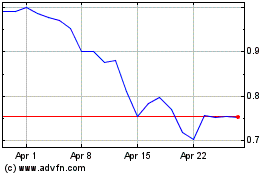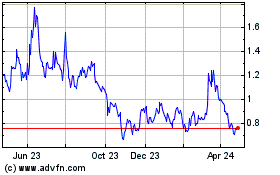Quantum Computing Inc. Demonstrates that “Domain-Wall” Encoding Delivers the Best Performance for Solving Real-world Optimization Problems
October 05 2021 - 9:30AM

Quantum Computing Inc. (the “company” or “QCI”) (Nasdaq: QUBT), a
leader in bridging the power of classical and quantum computing,
today announced research that provides evidence that “domain-wall”
encoding— a method for representing information in quantum
computers — delivers better performance for discrete optimization
problems than other methods. This breakthrough has significant
implications for a wide range of real-world challenges, such as the
traveling salesperson problem, which requires choosing an optimal
solution from an extremely large number of possibilities. QCI
Technical Advisor Dr. Nick Chancellor, who developed the method,
and was part of the research team that demonstrated its efficacy,
will present the paper at the D-Wave Qubits 21 conference on
October 6 at 3:45 PM ET.
Domain-wall encoding leverages topological defects (when
adjoining structures are out of phase) and Ising spin chains
(discrete variables that represent magnetic dipole spin moments) to
efficiently represent information in quantum computing
systems. Dr. Chancellor’s UK team, which also included
other QCI experts, proved that the domain-wall method is better
than others on annealers, like D-Wave’s, and will also likely excel
for gate model computers. For example, in a problem where discrete
variables can take three values, domain wall-encoding uses two
thirds as many qubits to solve the problem vs. other methods. It
also found results that other encoding techniques missed. Dr.
Chancellor will present their findings and discuss the relevance
for optimization problems, such as reconciling the distance between
cities for a traveling salesperson.
Interestingly, they demonstrated how encoding interacts with the
physics of the quantum processor to get better answers, an
important and often overlooked consideration. This post, on the QCI
blog provides a plain English but detailed explanation.
"It is really important to get as much as we can out of early
quantum computers, given how common discrete vs. binary problems
are in the real world,” said Dr. Nick Chancellor, who is also a
research and teaching fellow at Durham University. “This innovation
is an important step to advance our capabilities, especially given
the value we've found using this encoding. It did better in every
way we could think of for critical problems."
“Today’s initial domain-wall encoding innovation increases the
size of a problem that a quantum computer can solve by a factor of
30%,“ said Rebel Brown, VP, Strategy & Marketing for QCI. “As
quantum computers scale the number of qubits they support, we
expect this innovation, and others in development at QCI, to
significantly accelerate the time-to-viable-solution for production
problems using Qatalyst and quantum systems.“
Most real optimization problems involve discrete variables vs.
binary decisions. Consider transportation routing, in which a truck
can take any of three roads; microchip design, where a component
can be placed any of four places; scheduling an event that can
happen at any of seven times, or choosing the best of ten locations
to build a plant. While the choices are often not binary, classical
computers usually are. Discrete-to-binary encodings like the
domain-wall are highly useful for solving real problems that demand
discrete answers with quantum computers.
A paper describing the study is available on the ArXiv.org
preprint server, and is also undergoing peer review.
About Quantum Computing Inc.Quantum Computing
Inc. (QCI) (Nasdaq: QUBT) is focused on accelerating the value of
quantum computing for real-world business solutions. The company’s
flagship product, Qatalyst, is the first software to bridge the
power of classical and quantum computing, hiding complexity and
empowering SMEs to solve complex computational problems today.
QCI’s expert team in finance, computing, security, mathematics and
physics has over a century of experience with complex technologies;
from leading edge supercomputing innovations, to massively parallel
programming, to the security that protects nations. Connect with
QCI on LinkedIn and @QciQuantum on Twitter. For more information
about QCI, visit www.quantumcomputinginc.com.
Important Cautions Regarding Forward-Looking
StatementsThis press release contains forward-looking
statements as defined within Section 27A of the Securities Act of
1933, as amended, and Section 21E of the Securities Exchange Act of
1934, as amended. By their nature, forward-looking statements and
forecasts involve risks and uncertainties because they relate to
events and depend on circumstances that will occur in the near
future. Those statements include statements regarding the intent,
belief or current expectations of Quantum Computing (“Company”),
and members of its management as well as the assumptions on which
such statements are based. Prospective investors are cautioned that
any such forward-looking statements are not guarantees of future
performance and involve risks and uncertainties, and that actual
results may differ materially from those contemplated by such
forward-looking statements.
The Company undertakes no obligation to update or revise
forward-looking statements to reflect changed conditions.
Statements in this press release that are not descriptions of
historical facts are forward-looking statements relating to future
events, and as such all forward-looking statements are made
pursuant to the Securities Litigation Reform Act of 1995.
Statements may contain certain forward-looking statements
pertaining to future anticipated or projected plans, performance
and developments, as well as other statements relating to future
operations and results. Any statements in this press release that
are not statements of historical fact may be considered to be
forward-looking statements. Words such as “may,” “will,” “expect,”
“believe,” “anticipate,” “estimate,” “intends,” “goal,”
“objective,” “seek,” “attempt,” “aim to,” or variations of these or
similar words, identify forward-looking statements. These risks and
uncertainties include, but are not limited to, those described in
Item 1A in the Company’s Annual Report on Form 10-K, which is
expressly incorporated herein by reference, and other factors as
may periodically be described in the Company’s filings with the
SEC.
Qatalyst™ is the trademark of Quantum Computing Inc. All other
trademarks are the property of their respective owners.
Company Contact:Robert Liscouski, CEOQuantum
Computing, Inc.+1 (703) 436-2161Email Contact
Investor Relations Contact:Ron Both or Grant
StudeCMA Investor Relations+1 (949) 432-7566Email Contact
Media Relations Contact:Bob GellerFusion Public
Relations+1 (917) 816-0562qci@fusionpr.com
Quantum Computing (NASDAQ:QUBT)
Historical Stock Chart
From Mar 2024 to Apr 2024

Quantum Computing (NASDAQ:QUBT)
Historical Stock Chart
From Apr 2023 to Apr 2024
